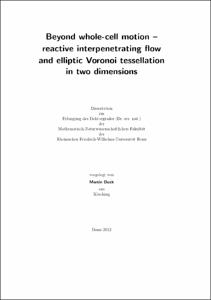Oemisch, Mamke: Geomorphological Dating of Scarps in Temperate Climate Using a Modified Diffusion Model : in Temperate Climate Using a Modifed Diffusion Model. - Bonn, 2004. - Dissertation, Rheinische Friedrich-Wilhelms-Universität Bonn.
Online-Ausgabe in bonndoc: https://nbn-resolving.org/urn:nbn:de:hbz:5N-04421
Online-Ausgabe in bonndoc: https://nbn-resolving.org/urn:nbn:de:hbz:5N-04421
@phdthesis{handle:20.500.11811/2098,
urn: https://nbn-resolving.org/urn:nbn:de:hbz:5N-04421,
author = {{Mamke Oemisch}},
title = {Geomorphological Dating of Scarps in Temperate Climate Using a Modified Diffusion Model : in Temperate Climate Using a Modifed Diffusion Model},
school = {Rheinische Friedrich-Wilhelms-Universität Bonn},
year = 2004,
note = {Geomorphological dating of a certain landform or geomorphological structure is based on the evolution of the landscape itself. In this context it is difficult to use common absolute dating techniques because they require datable material which is often not available. Additionally, these methods do not always date the time since the formation of these structures. For these reasons the application of geomorphological dating seems one possibility to date certain geomorphological features.
The aim of this study was to relate present-day shapes of terrace risers to their ages. The time span since scarp formation ceased is reflected by the stage of degradation along with the rounding of the profile edges due to erosive processes. It is assumed that the average rate of downslope soil movement depends on the local slope and can be described by a diffusion equation. Furthermore, present-day scarps are often asymmetric and suggest a higher diffusivity at the base than at the toe of a slope. The diffusion equation has been modified and a linear approach with increasing diffusivity in downslope direction is suggested and assimilated in a model to obtain a better fit between observed and simulated profiles.
In order to date the scarps, the model had to be calibrated. For this purpose, published diffusivities taken from literature were used as well as estimated diffusivities by fitting modelled profiles to observed ones of known age. Field data were collected in the area around Bonn, Germany, and in Valais, Switzerland. In addition, profiles from literature which have already been dated were digitized. For the general use of geomorphological dating, a Java tool was developed where, e.g., different initial profiles and diffusivities can be chosen. Results show a better match between simulated and observed profiles in comparison to models using a constant diffusivity. But a reliable calibration of the model finally failed which brings up the question whether the diffusion equation and the presented modification are really an adequate description of the geomorphological processes degrading a slope.},
url = {https://hdl.handle.net/20.500.11811/2098}
}
urn: https://nbn-resolving.org/urn:nbn:de:hbz:5N-04421,
author = {{Mamke Oemisch}},
title = {Geomorphological Dating of Scarps in Temperate Climate Using a Modified Diffusion Model : in Temperate Climate Using a Modifed Diffusion Model},
school = {Rheinische Friedrich-Wilhelms-Universität Bonn},
year = 2004,
note = {Geomorphological dating of a certain landform or geomorphological structure is based on the evolution of the landscape itself. In this context it is difficult to use common absolute dating techniques because they require datable material which is often not available. Additionally, these methods do not always date the time since the formation of these structures. For these reasons the application of geomorphological dating seems one possibility to date certain geomorphological features.
The aim of this study was to relate present-day shapes of terrace risers to their ages. The time span since scarp formation ceased is reflected by the stage of degradation along with the rounding of the profile edges due to erosive processes. It is assumed that the average rate of downslope soil movement depends on the local slope and can be described by a diffusion equation. Furthermore, present-day scarps are often asymmetric and suggest a higher diffusivity at the base than at the toe of a slope. The diffusion equation has been modified and a linear approach with increasing diffusivity in downslope direction is suggested and assimilated in a model to obtain a better fit between observed and simulated profiles.
In order to date the scarps, the model had to be calibrated. For this purpose, published diffusivities taken from literature were used as well as estimated diffusivities by fitting modelled profiles to observed ones of known age. Field data were collected in the area around Bonn, Germany, and in Valais, Switzerland. In addition, profiles from literature which have already been dated were digitized. For the general use of geomorphological dating, a Java tool was developed where, e.g., different initial profiles and diffusivities can be chosen. Results show a better match between simulated and observed profiles in comparison to models using a constant diffusivity. But a reliable calibration of the model finally failed which brings up the question whether the diffusion equation and the presented modification are really an adequate description of the geomorphological processes degrading a slope.},
url = {https://hdl.handle.net/20.500.11811/2098}
}









